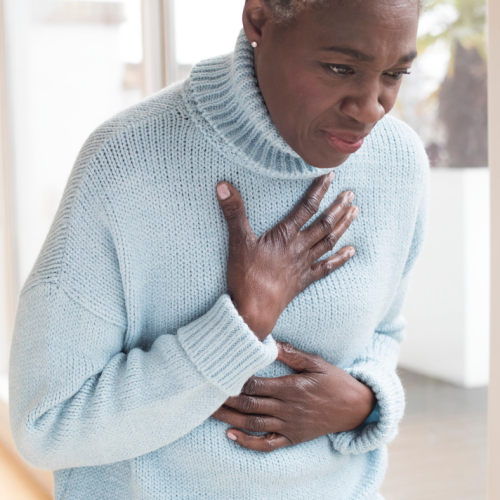Chronic Obstructive Pulmonary Disease (COPD)
COPD is a term for a number of progressive lung diseases that can progress gradually and make it harder to breathe over time. The most common lung diseases that can lead to COPD are chronic bronchitis and emphysema.
Chronic bronchitis – Your bronchial tubes are responsible for moving air in and out of your lungs. The lining of these tubes is covered with cilia (small, hair-like structures) that normally remove mucus from your airways. When these tubes are damaged by pollutants or smoking, they swell and mucus accumulates along the lining, narrowing the opening and making it difficult for air to get in and out of your lungs.

Emphysema – In the lungs there are air sacs called alveoli. They are located at the ends of each bronchial tube throughout the lungs. When they are damaged, the inner walls of the alveoli weaken and rupture – creating larger air spaces instead of many smaller ones. This reduces the surface area of the lungs and therefore the amount of oxygen that reaches your bloodstream.
Symptoms of COPD
COPD symptoms often do not appear until the lungs are already severely damaged. These symptoms will gradually worsen, especially if lifestyle changes are not made. Symptoms may include:
- Shortness of breath, especially during physical activities
- Wheezing
- Chest tightness
- A chronic cough that may produce mucus (sputum) that may be clear, white, yellow or greenish
- Frequent respiratory infections
- Lack of energy
- Unintended weight loss (in later stages)
- Swelling in ankles, feet or legs
Causes of COPD
Smoking – Up to 90% of COPD cases is caused by tobacco use. Tobacco smoke irritates the airways and causes inflammation (irritation and swelling) that narrows the airways. The smoke also damages the cilia so that they can no longer do their job of removing mucus and particles from the airways.
Other pollutants, toxins, and irritants – These include second-hand smoke, air pollution and workplace dust and fumes
Genetics – There is a rare genetic disorder that causes AAT (alpha-1 antitrypsin) deficiency. AAT is an enzyme that helps protect your lungs from the harmful effects of inflammation. If you do not produce enough AAT, your lungs are more likely to be damaged by irritating substances like smoke and dust.
Treatment and management of COPD
COPD treatment focuses on relieving symptoms such as coughing and breathing problems, preventing respiratory infections, and reducing pain and improving breathing efficiency and fitness. These may include:
Medication – Specific medication may be prescribed by your doctor. Medications may include:
- Bronchodilators will relax your airways and help you breathe easier.
- Anti-inflammatories will lower inflammation in your lungs.
- Antibiotics to help stop bacterial infections and prevent further damage.
- Vaccinations to help minimize your symptoms if you do get an infection.
- Anticholinergics to relax the muscle bands. This helps clear mucus from the lungs and allows more air in and out, making coughing easier.
- Supplemental oxygen to counter hypoxemia (low blood oxygen levels). You may need to use a portable oxygen tank.
Pulmonary Rehabilitation – Rehabilitation programs teach effective breathing strategies to lessen shortness of breath and on conditioning. When maintained, fitness can increase the amount you can do with the lungs you have. Benefits may include:
- Improve your ability to do everyday things, such as housework, outings with family or exercise.
- Have fewer symptoms, such as less coughing or less shortness of breath and know how to manage your symptoms.
- Feel more comfortable or less anxious.
- Feel less tired and have more energy.
- How to best use your medicines to treat your lung disease.
- How to use medical equipment at home when you need it.
- How to eat right and control your weight and diet.
- Improve overall quality of life.
Treatment and prevention at A7 Health for Chronic Obstructive Pulmonary Disease (COPD):
Get Pulmonary Rehabilitation – Book an appointment with a Physiotherapist at A7 Health who will assess you in a 45 minute consultation and provide treatment alongside a treatment plan to reduce symptoms and improve breathing efficiency. Some of the treatments include:
- Massage to relieve pain, increase blood flow and reduce inflammation.
- Breathing techniques to improve lung efficiency and fitness.
- Education on optimal use of medications, use of specialized equipment, nutrition, and weight control.
